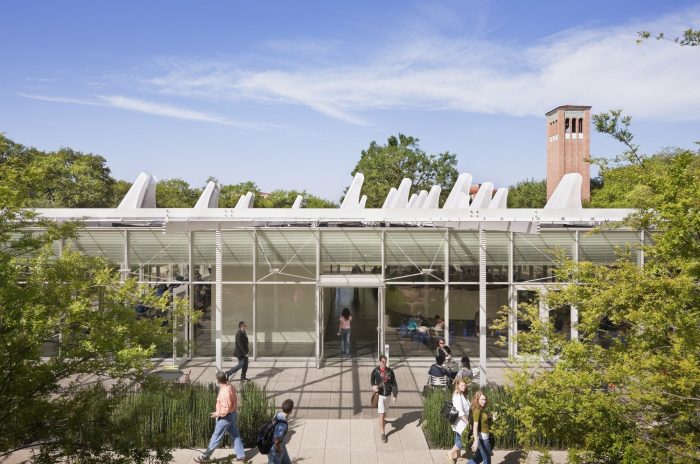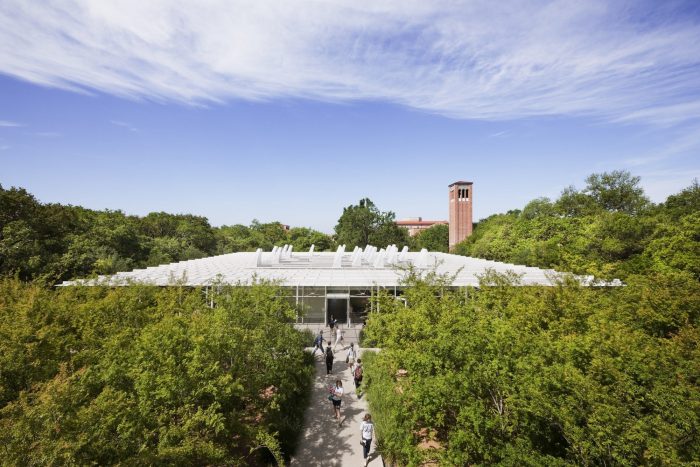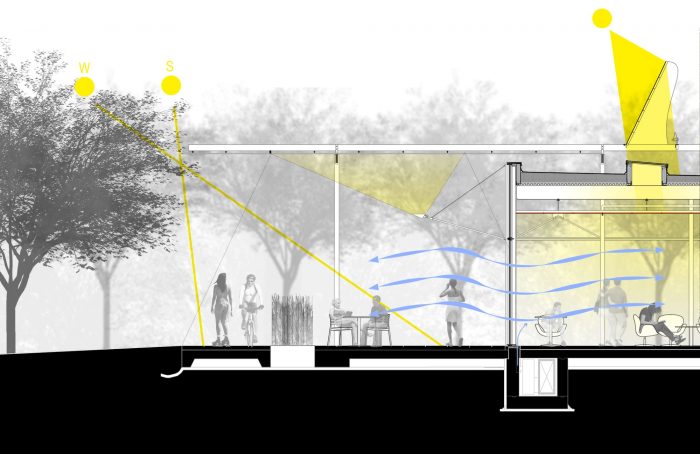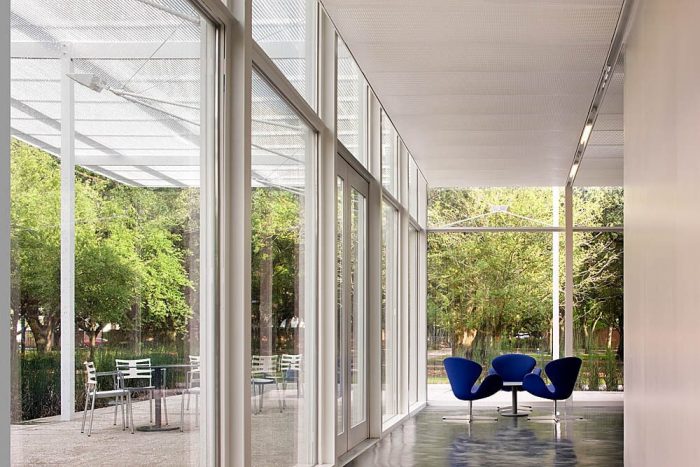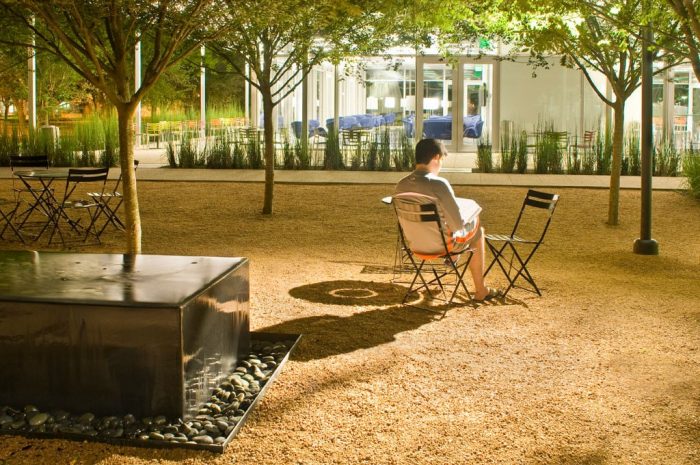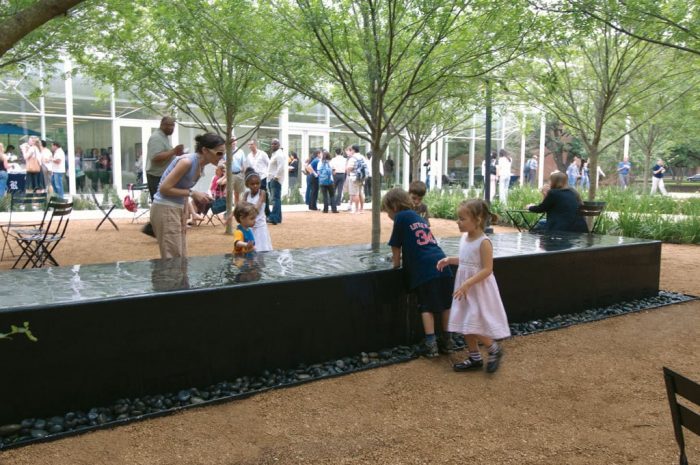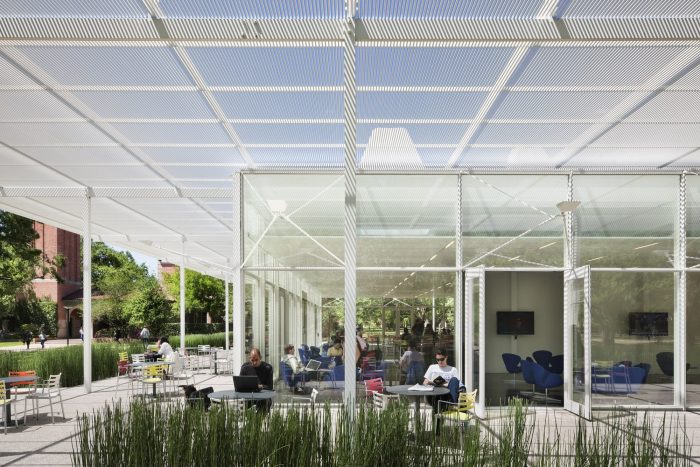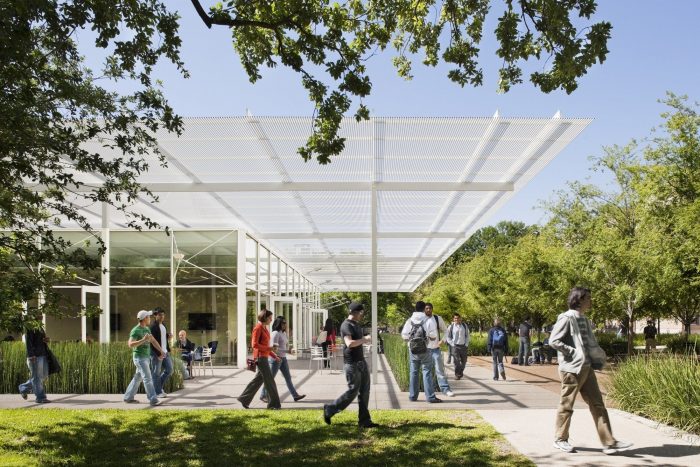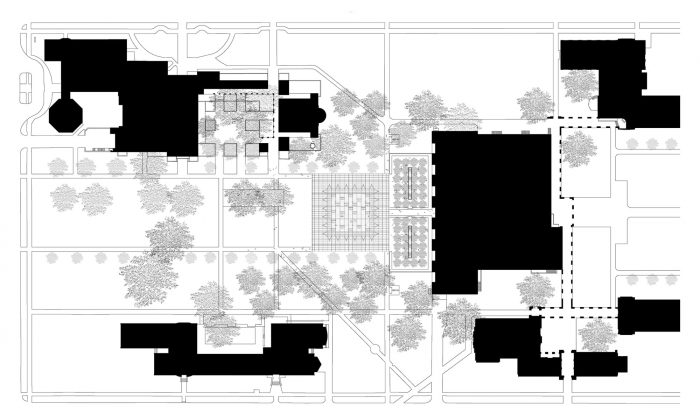雷蒙德和苏珊-布罗赫斯泰因馆被设想为莱斯大学校园的一个标志性目的地,它展示了景观建筑促进社会互动和改善人类状况的能力。布罗赫斯泰因馆的花园是对节制和纯粹形式的研究,它创造了一个强大的空间框架,将一个无序的、未被充分利用的四合院转变为校园内学生活动的中心。
Conceived as a landmark destination for Rice University’s campus, the Raymond and Susan Brochstein Pavilion demonstrates the ability of landscape architecture to foster social interaction and improve the human condition. A study in restraint and the purity of form, the garden at the Brochstein Pavilion creates a powerful spatial framework that has transformed an unstructured, underutilized quadrangle into the center of student activity on campus.
莱斯大学校园成立于1912年,以其不拘一格的地中海式建筑、成熟的南方活橡树和强调长而正式轴线的古典校园规划而闻名。在整个2005年让学生、教师和校友参与关于大学未来的对话后,董事会批准了 “第二个世纪的愿景”。一个积极的战略计划,认识到校园文化中场所建设的重要性,该愿景承认需要 “提供空间和设施,在校园内培养更大的活力和生机,并促进社区意识”。受巴黎杜乐丽花园的启发,休斯顿建筑师Raymond Brochstein和他的妻子Susan提供了一笔慷慨的捐款,使大学能够实现这一目标。
Founded in 1912, the Rice University campus is noted for its eclectic Mediterranean architecture, mature southern Live Oaks and a classical campus plan that emphasizes long, formal axes. After engaging students, faculty and alumni in a dialogue throughout 2005 regarding the future of the university, the Board of Trustees approved “A Vision for the Second Century.” An aggressive strategic plan that recognizes the importance of placemaking in campus culture, the Vision acknowledges the need to “provide the spaces and facilities that will cultivate greater dynamism and vibrancy on the campus and foster sense of community.” Inspired by the Tuileries Gardens in Paris, Houston architect Raymond Brochstein and his wife Susan provided a generous donation that allowed the University to achieve this goal.
大学向纽约的Thomas Phifer和合伙人以及James Burnett办公室提出挑战,要求他们制定一个方案,以应对中央四合院的限制。该四合院原本是校园的主要东西轴线,但由于1940年增加了冯德伦图书馆,该四合院被破坏了。在1968年图书馆的大幅扩建和邻近建筑的建设之后,四合院成为附属空间。设计团队放弃了通常适用于校园新建筑的严格的建筑准则,负责创造一个标志性的校园地标,提供灵活的、非计划性的空间,成为校园的社交中心。
The University challenged Thomas Phifer and Partners of New York and the Office of James Burnett to develop a scheme that responded to the constraints of the Central Quadrangle. Originally the primary east-west axis of the campus, the quadrangle was disrupted by the addition of the Fondren Library in 1940. Following a significant library expansion in 1968 and the construction of adjacent buildings, the quadrangle became ancillary space. Waiving the stringent architectural guidelines that typically apply to new construction on campus, the design team was charged with the creation of an iconic campus landmark that would offer flexible, non-programmed space that would become the social hub of the campus.
布罗赫斯坦亭由一个钢铝花架结构覆盖,它保护着建筑,并向各个方向延伸,以覆盖和遮蔽周围的座位平台。棚架由铝管组成,保护建筑不受德克萨斯州恶劣阳光的影响。悬停在整个结构上并为其遮阳,该棚架平均减少了70%的阳光直射。这种广泛的遮阳保护将所需的机械冷却负荷降低了30%,并使该结构在一年中的大部分时间都能开放和自然通风。馆内一系列宽大的双门将室内座位区与周围的露台连接起来,使馆内的景观开放,并欢迎学生和教师的到来。
The Brochstein Pavilion is capped by a steel and aluminum trellis structure which protects the building and extends in all directions to cover and shade the surrounding seating terrace. The trellis, consisting of an aluminum tubes, protects the building from the harsh Texas sun. Hovering over and shading the entire structure, the trellis cuts the direct sun by an average of 70%. This extensive shade protection reduces the required mechanical cooling load by 30% and allows the structure to be open and naturally ventilated throughout much of the year. A series of wide double doors at the pavilion connect the interior seating areas with the surrounding terrace, opening the pavilion to the landscape and welcoming students and faculty.
幕墙系统的开放性建立了与景观的紧密联系,鼓励馆内活动流向周围的四合院。日光通过天窗被外部的穿孔铝制遮阳板扩散器和内部的穿孔金属天花板系统仔细过滤,为空间注入精心控制的柔和自然光线,并进一步将展馆与环境联系起来。Brochstein馆的内部由充满活力的休闲座椅组和无缝的可丽耐亭激活。馆内规划设计为小型的即兴聚会以及大型的公共活动,如计划在中央四合院举行的音乐会。
The openness of the curtain wall system establishes a strong connection to the landscape, encouraging activities within the Pavilion to flow out into the surrounding Quadrangle. Daylight is carefully filtered through skylights by perforated aluminum sunshade diffusers at the exterior and by a perforated metal ceiling system at the interior, infusing the space with carefully controlled, soft natural lighting and further connecting the pavilion to the environment. The interior of the Brochstein Pavilion is activated by vibrant, casual seating groups and a seamless Corian kiosk. The interior Pavilion plan designed for small impromptu gatherings as well as large public functions such as concerts which are planned for the central Quadrangle.
景观设计师没有把大部分精力放在建筑西面的四合院上,而是选择了解决方德伦图书馆和亭子之间的间隔空间。与建筑的网格相呼应,48棵标本阿利花椰树的丛林从分解的花岗岩中升起,提供了一个组织框架,使空间的规模人性化。一条连接图书馆和展馆的宽敞的混凝土路将丛林一分为二,变成了花园房间,其周边由非洲鸢尾花的种植来界定。长长的黑色混凝土喷泉充满了沙滩石,占据了每个空间的中心,使花园充满了流水的淙淙声,并通过树冠反射出过滤的光线。可移动的家具和微妙的现场照明使游客们可以在白天或晚上临时聚集在一起,享受由浓密的树荫和流水创造的绿洲。
Rather than focusing the majority of their energy on the quadrangle west of the building, the landscape architect instead chose to address the interstitial space between the Fondren Library and the pavilion. Responding the grid of the building, a bosque of 48 specimen Allee Lacebark Elms rise from a plane of decomposed granite and provide an organizational framework that humanizes the scale of the space. A generous concrete walk connecting the library and the pavilion bisects the grove into garden rooms whose perimeters are defined by plantings of African Iris. Long black concrete fountains filled with beach stone occupy the center of each space, filling the garden with the murmur of running water and reflecting the filtered light through the canopy. Movable furniture and subtle site lighting allow impromptu gatherings of visitors to enjoy the oasis created by the dense shade and running water day or night.
为了尊重建筑的轻盈性,景观设计师在其他地方做了最少的干预。新的混凝土路和一排标本活橡树加强了四合院现有的空间框架。尽管由于洪泛区的要求,必须要有一个比现有地势高得多的完成层标高,但建筑师倾向于一个不会将建筑孤立在一个引人注目的基座上的解决方案。景观设计师仔细考虑了现有的树木,巧妙地操纵了走道的平整度,使建筑融入景观,克服了校园的悲惨平坦。
Respecting the lightness of the building, the landscape architect made minimal interventions elsewhere. New concrete walks and a row specimen Live Oaks reinforce the existing spatial framework of the quadrangle. Although the floodplain requirements necessitated a finish floor elevation considerably higher than existing grade, the architects favored a solution that would not isolate the building on a dramatic plinth. Carefully considering the existing trees, the landscape architect subtly manipulated the grading of the approach walks so that building feathers into the landscape and overcomes the tragic flatness of the campus.

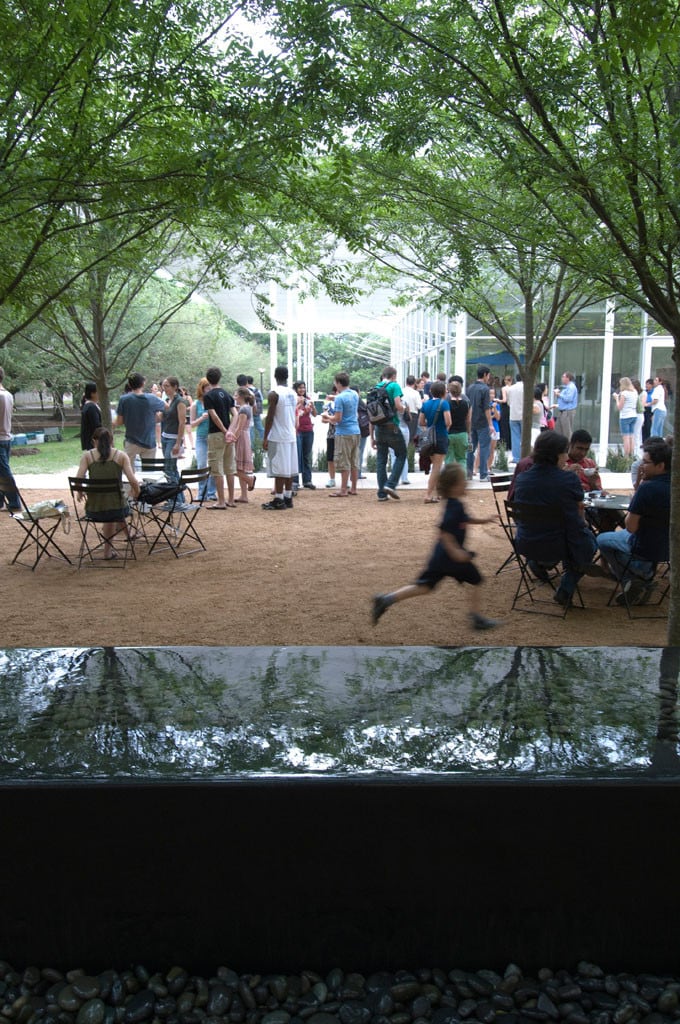
Architects: The Office of James Burnett, Thomas Phifer and Partners
Area : 557 m²
Year : 2007
Photographs :Scott Frances, OJB
Lighting Design : Fisher Marantz Stone
Landscape Architect : The Office of James Burnett
Civil Engineering : Walter P. Moore & Associates
Client : Rice University
City : Houston
Country : United States


